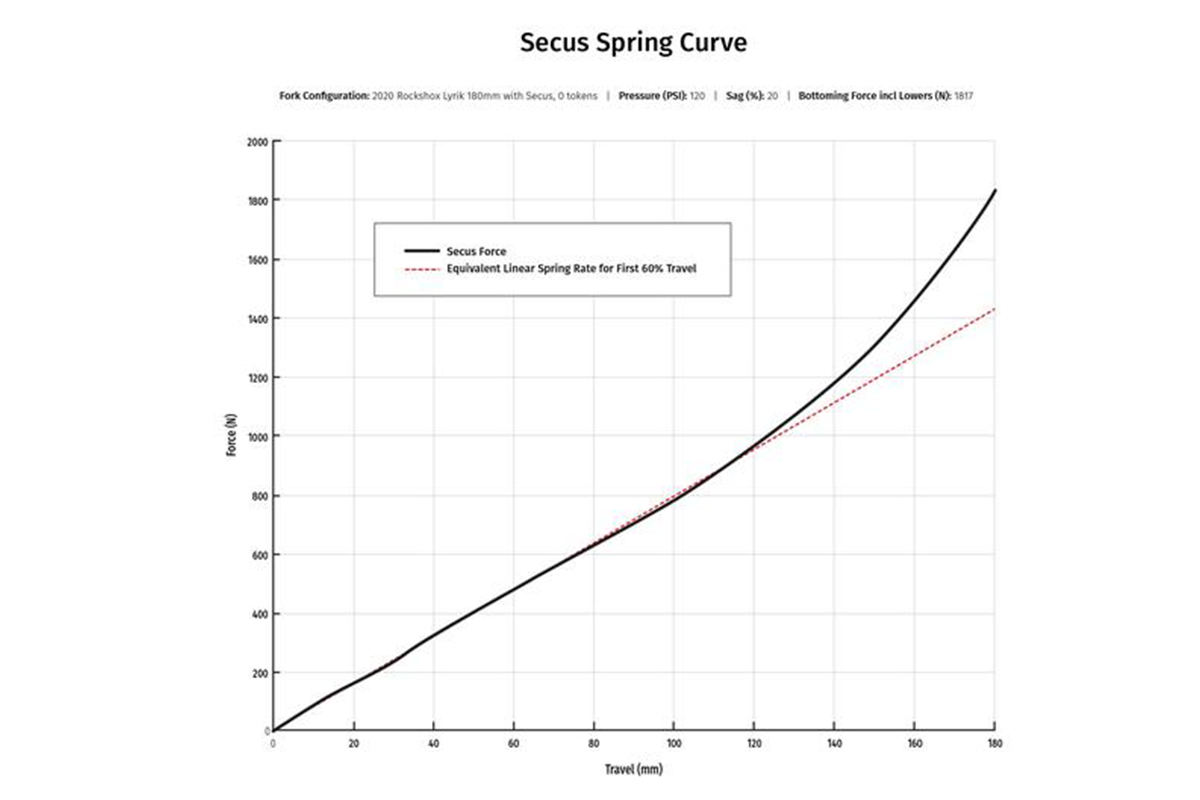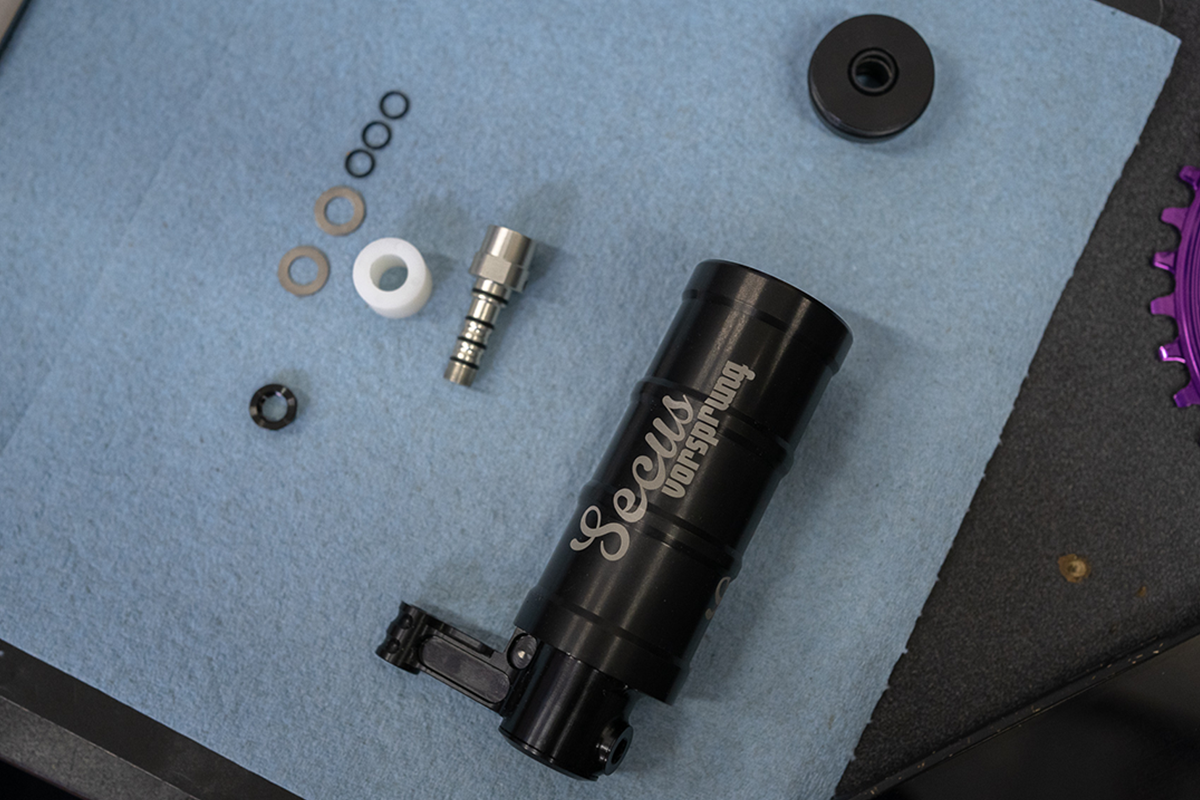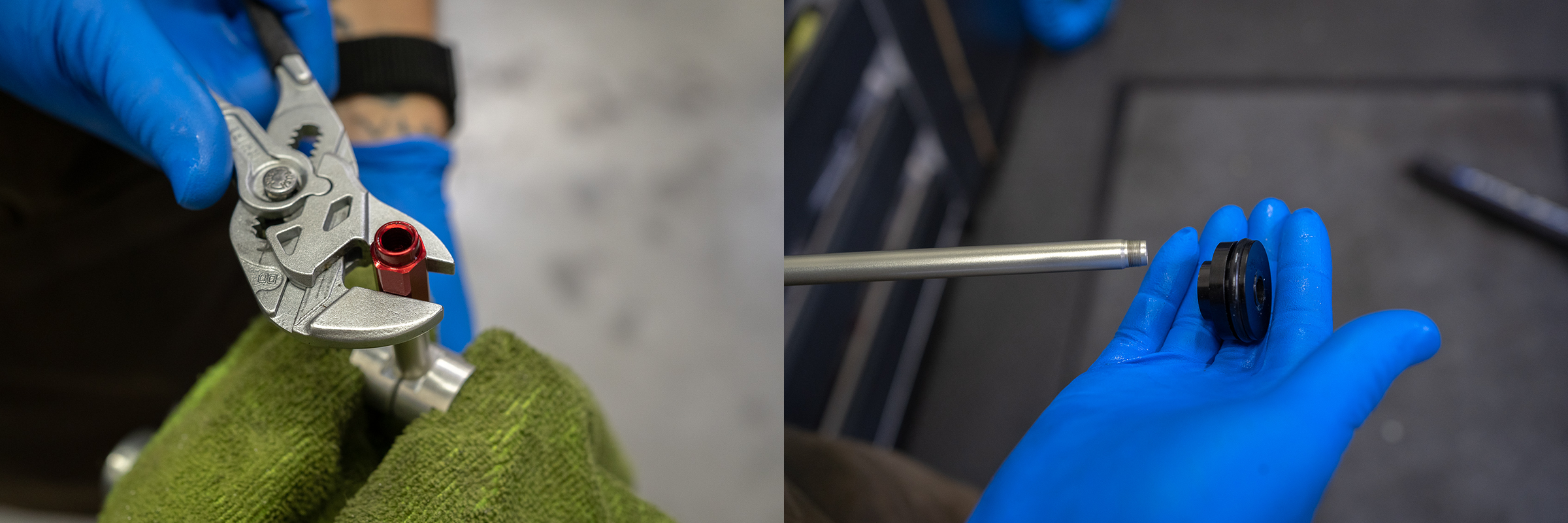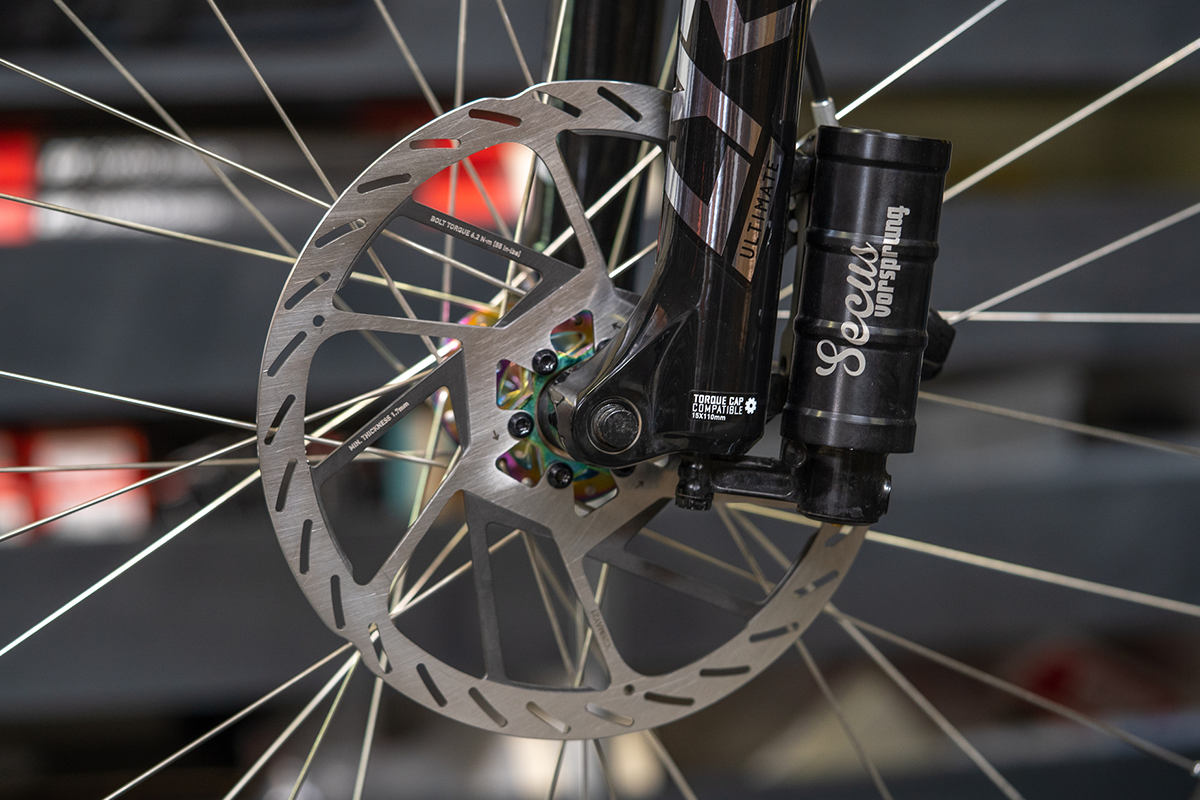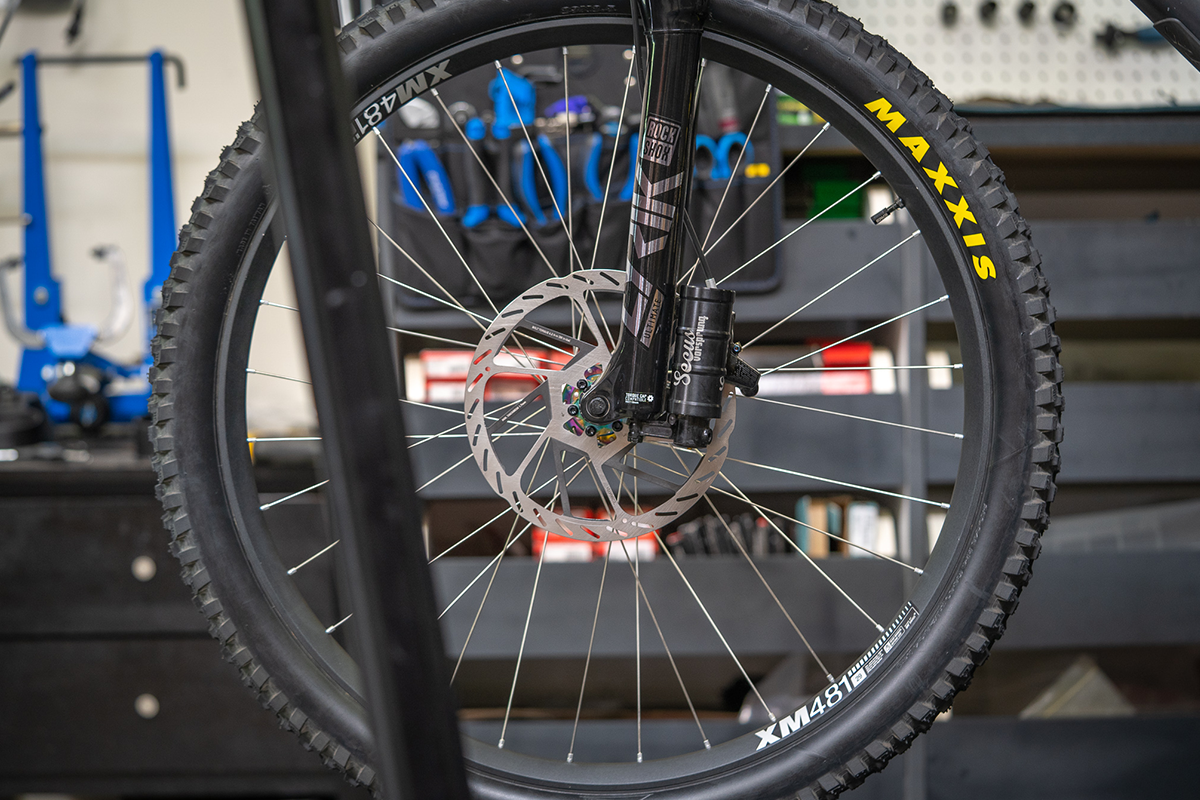- Continue Shopping
- Your Cart is Empty
Vorsprung Secus - An Air Spring Upgrade That Works! [Review]
Words by: Liam Woods
Vorsprung Secus - What is it and why do you want it?
Suspension, in general, has come a very long way in the past five or so years on mountain bikes. I like to say that the RockShox Pike was the beginning of the revolution and then ever since both Fox and Rockshox (and a few other brands) have been in stiff competition. One of the other brands that contributes to the suspension race doesn’t actually make a full suspension product themselves but instead makes additions and modifications for RockShox and Fox suspension. That brand is Vorsprung and they have been making suspension products that provide better suspension tuning for specific rider types for years now, and their newest product, the Secus, is no different.
The Vorsprung Secus starts at $354 for the Secus can alone. If you need the shaft clamps (probably recommended unless you have a shop with tools and shaft clamps), or if you have a C1 RockShox fork which requires a different seal head, you’ll have to pay a little extra. The Secus adds about 130g to your fork, so if you are counting those grams, their Luftkappe Air Piston is a lighter option that has a similar, but not as noticeable effect on the fork.
What is a Secus, you might ask? The Secus is an external air can that connects to the air chamber in your fork to help enlarge the negative air spring and change the spring curve or spring rate throughout the travel of the fork. By adding this to your bike you will change the initial stroke, mid-stroke and end stroke of the fork. The idea is to help create a more coil-like feeling for the beginning and mid-stroke, then progressively ramp up toward the end, creating a perfect balance of coil-like feel and air.
Why would you want this? Air suspension is the most common type of suspension now on the market, and for good reason. With a shock pump, you can change the air pressure or spring rate of the shock or fork to fit a wide range of riders on the same bike. So it’s very universal and easy to spec as a stock option on most bikes, from the entry level full suspension rigs to the highest end bike upwards of $10,000. Air is also lighter than a coil spring, too. Sounds great right? Easy to adjust, you can make small spring rate changes (PSI) and it’s lighter than the coil sprung option, so it’s a no-brainer! Well, not entirely. Air, while great for most riders, still has some downsides. When compressed, air has an increasing spring rate, meaning that the same amount of force to move your travel at the beginning of the stroke might not even move in the last ¾ of the travel. It also takes more initial force to initiate the fork or shock to move with air, while coil takes almost zero force. Lastly, and what the Secus is trying to fix, is the spring curve takes on a different, and to some, not ideal path. As mentioned above, the air spring curve takes more force to start moving the fork into the travel, but then the amount of force necessary actually regresses in the middle, creating a feeling of “blowing through the mid-stroke” or what other riders refer to as “lacking mid-stroke support.” Then you get to the last ⅓ of travel on an air fork and the spring rate increases sometimes very dramatically, making it hard to use full travel and can feel harsh to some riders depending on their setup. I’ll get into more of those details with graphics below, but to answer my question up top, if you feel like your fork is a bit harsh off the top or at the beginning of the travel, but then you “dive” into the last ⅓ of the travel, the Vorsprung Secus might be the air spring upgrade you want.
How Does The Secus Improve Your Fork?
- Allows more lower leg bath oil to be used for superior lubrication
- Initial stroke - enlarged negative air spring chamber delivers a soft, supple initial stroke for ultimate small bump compliance
- Mid-stroke - where traditional air spring rates drop off in the mid-stroke, their proprietary Mid-stroke Support Valve technology boosts the mid-stroke spring rate to maintain linearity, for support, predictability, ride height and compliance
- End stroke - enlarged lower leg volume reduces overall progression even at higher pressures and allows for a wider range of end stroke ramp options to be utilized with standard fork volume spacers.
- Plush and predictable like a coil, bottomless like an air spring
I’m going to let Vorsprung provide some of the really nerdy details on the Secus since we don’t have the lab testing and insights that Vorsprung has. Below you will find a graph and their three stages of control explained.
“By independently optimizing the beginning, middle and end portions of the stroke, the Secus gives you the linear-to-progressive spring rate that coil springs and traditional air springs alike wish they had.” - Vorsprung
Secus Advantages:
- An enlarged negative air spring chamber delivers a soft, supple initial stroke for ultimate small bump compliance (yes, even compared to the Luftkappe)
- Proprietary Mid-stroke Support Valve improves predictability and support beyond the sag point
- Reduced lower leg pneumatic ramp means better scalability of the air spring, particularly for light riders who previously struggled to use full travel
- Plush and predictable like a coil, bottomless like an air spring
- Allows full use of travel in both directions - fully extends to topout without any quibbles (including on Debonair B1 air springs) and fully compresses without the excessive ramp
- Allows more lower leg bath oil to be used for superior lubrication
- Considerably lighter than coil conversions - adds approximately 130g
- Simple setup - inflate fork, bounce on it a few times, press MSV charge button, go ride
- Compatible with OEM volume spacers for end stroke progression adjustment
- Compatible with other aftermarket top-cap systems such as DSD Runt and MRP Ramp Control
- Lower compression ratios mean a more consistent spring rate
- Transferable between any Secus-compatible forks with only a foot stud to change at most
Installation:
Installing the Secus does require some specialty tools but is not much more difficult than doing your standard lower leg service. So if you are not familiar with a lower leg service, or are not very mechanically inclined, then you might want to consider taking this to a shop for the installation. When you buy the Secus there is an option to get shaft clamps. If you do not have a shop or toolbox stacked with some suspension tools, then you will most likely need to get those.
You will then need any and all tools required to service your lower legs on your brand of fork. This list of tools will differ depending on whether you have Fox, RockShox, or some other brand. It would also be a good idea to do your fork seals at the same time while they’re out, but keep in mind that just by doing fresh seals, oil, and grease your fork will already feel better and be more supple off the top.
At this point, check out the Vorsprung installation guide for full details, torque ratings, lower fork oil volumes and other important bits of information.
Once you have your lower legs taken off, you need to remove your air spring, which I always recommend doing with every lower leg service as that has so much control over how your fork feels. Removing any extra grease and adding fresh grease to the seals of the air spring will help make sure your fork has the correct negative and positive air chamber pressures.
This is where you will need the shaft clamps, and maybe even a heat gun, too. Once you install the new footnut you can start putting the fork back together. Follow all the steps as Vorsprung says and add the correct amount of oil per your fork’s specifications. This next step is where you actually install the Secus. Follow the supplied instructions again here.
As you are installing the fork and before you add any air pressure, I think it’s worth considering taking out one volume spacer, if you’re running any. I had two in my Lyrik before my Secus, and once I installed it, I discovered two was overkill. I immediately took one out, leaving me with only one.
Then follow the instructions on how to air up and where to start with your initial pressure. They suggest going about 20% more air pressure than what you ran in the stock fork. For myself I was running about 73 PSI so I went to 88 PSI to start. Make sure that when you are pumping up your fork, you follow the Vorsprung instructions to make sure you do it correctly. It’s crucial to follow their directions here to get the intended feeling.
Setup & Riding Impressions:
As mentioned before, when setting up the Secus for the first time I started with a PSI of 88 in my fork. I got this number as I was running about 73 PSI previously and added 20% to that, putting me at 88 PSI. To keep the number of changes to a minimum I wanted to try the fork with all my old settings and just the Secus installed with 88 PSI. I left all my compression and rebound settings the same, and I hadn’t touched my volume spacers yet. In the parking lot it felt decent, a touch on the stiffer side but I wanted to feel it on the trail.
Upon my first ride I could immediately tell there is more support throughout the fork, specifically in the mid-stroke. It was the most apparent change and would take some time getting used to it. That was the most notable change on the first ride, so much so that it felt a bit harsh to me. I think the harsh feeling comes more from not being used to having so much mid-stroke support and feeling the fork dive into the travel whereas with the Secus there is no dive. It does feel a bit softer off the top and on small bumps you can tell, but the real feeling is in the mid-stroke. After this first ride it was clear I did need to make some adjustments. I started by backing off some compression, specifically the HSC. When I got into the mid-stroke I didn't want both the support of the air spring and the damper to keep the fork higher in its stroke. Having the two work together was overkill for me. I backed off the HSC to wide open for now, (five positions from closed). I didn’t really touch the LSC since I normally run it fully open for the best small bump compliance. Finally, I removed one token from the air chamber for a total of just one.
These changes helped over the next few rides, and the fork started to feel more familiar. Over the next few rides I didn't change anything, and instead just tried to get the feel for the new stroke of the fork and how the Secus really does change the air springs characteristics.
To me, I feel like the Secus provides plenty of support. It’s almost so much that I wanted to feel what it was like if I dropped the pressure a bit from 88 PSI. So I dropped it down to 83PSI, a pretty big change but I wanted to see if that still gave me the mid-stroke support the Secus seems to provide, while getting the off the top small bump compliance to feel less harsh and make it even softer. This certainly seemed to help get the fork to feel a bit more balanced, and I found that it still sat high enough in the travel while still having more mid-stroke support and a softer off the top feel than the stock setup. This drop in PSI to 83 is where I ended up riding the fork for most of my testing period, occasionally I would add some HSC to the fork if I was riding anything steeper or with some bigger hits. One of our riding zones you almost always have to add some HSC to your fork and rear shock as well as sometimes a few PSI since the trails are steeper than anything we normally ride. I really liked the Secus here and the setup I was riding. The combination of the softer off the top feel with a more linear mid-stroke helped keep the fork up in its travel and provided lots of confidence on the steeper terrain and with larger compressions.
The real difference for me is always going back to my stock setup. I feel when I add something to my bike I often set it up, make a few tweaks and then get used to it without much afterthought, unless it's really amazing or really bad. The Secus fell into this, where after I played a bit with the PSI and setup, I ended up not noticing it much, and that isn't a bad thing. I actually prefer this as I don't like to think much about my bike while riding and prefer to just focus on the trail. When I changed back to the stock air spring for testing purposes I really could notice the benefits of the Secus and what it does with the air spring. While the fork almost seems to feel softer, I realized that the lack of mid-stroke made you feel the “soft” feeling but then adding more PSI to either get close to the mid-stroke or help reduce any dive ended up making the beginning of the travel much too harsh.
Highs & Lows:
Highs:
- Softer off the top feel improves traction and small bump
- Greatly improves mid-stroke support
- Improves tunability of the fork’s spring curve
Lows:
- Air can sticks out and could hit more objects
- Installation requires mechanic skill and some specialty tools
- Price, expensive upgrade
Worldwide’s Final Thoughts:
The Vorsprung Secus is an air spring upgrade for your Fox or RockShox fork that claims to improve the air spring curve with a softer off the top feel while improving mid-stroke support. I can say that all these claims are true. The mid-stroke support is huge and what I consider to be the biggest benefit of the Secus. While the Secus is $354 USD, which makes it a bit steep for most to make the upgrade, I would highly recommend the Vorsprung Secus if you are looking to get rid of brake dive and have your fork sit higher in its travel on steep terrain. With a 12 month crash replacement warranty, the only risk is liking it so much you have to buy them for all your bikes.
This article was written / authored by Liam Woods. Liam has been in the bicycle industry for over 10 years as a racer, professional mechanic, service manager and as of late, media and content creator. Liam has ridden thousands of different bikes, ridden countless components, tested endless MTB apparel of all kinds and written reviews on it all. He's a key piece to the Worldwide Cyclery "All Things MTB" content creation puzzle. He also makes consistent appearances on the Worldwide Cyclery YouTube channel and Instagram.


